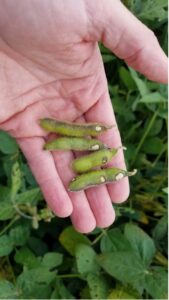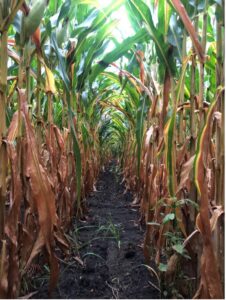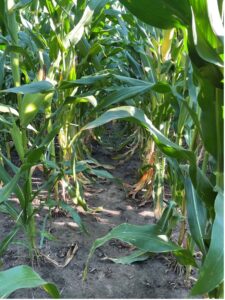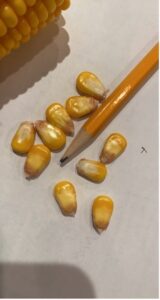Nick Seiter, Extension Field Crops Entomologist, University of Illinois
Second generation bean leaf beetle adults have been emerging over the last few weeks; pod scarring has been an issue in some areas over the last two years. Consider scouting your R6 beans, particularly in fields that you expect to mature late. Remember it takes a lot of beetles and a lot of this sort of damage to reduce yield and/or quality. The beetles do not directly feed on the seed, but their feeding can allow moisture into the pods as they start to dry down.

Pod scarring (R6) from bean leaf beetle feeding observed in 2020.
Emerson Nafziger, Extension Agronomist Emeritus, University of Illinois
I posted an article on September 1 mentioning some of the issues as corn maturity and harvest approach. Maturity is approaching rapidly, helped along by warm temperatures: we expect most of the Illinois corn crop to reach black layer by mid-September. Although soil moisture is low in some areas, most fields have enough to get plants to maturity. There’s no clear reason to consider the August 1 estimate by NASS of 203 bushels per acre too high or too low, so we’ll hold onto it until the September 1 update, to be released on September 12. The soybean crop continues to have good canopy color, with little sign yet of leaf color loss that signals the movement of nitrogen from leaves to seeds and the beginning of maturation. Soybean development remains a little delayed, possibly because of dryness in June and July.
Trent Ford, Illinois State Climatologist, Illinois State Water Survey
We wrapped up August with another pleasant weather week. Temperatures this past week ranged from the low-70s in Northern Illinois to the high-70s in Southern Illinois, about 1 to 2 degrees above normal. Official numbers will be released next week, but it looks like August ended just a few tenths of a degree above normal statewide, notably cooler than Augusts of 2020 and 2021. Rain totals this past week ranged from over 4 inches in Eastern Illinois to less than a tenth of an inch in Western Illinois. August ended wetter than normal in most places outside of Western Illinois, and last month was the wettest on record in Freeport and the fifth wettest on record in Rockford. Meanwhile, a large swath of Western Illinois was very dry last month, and in response to worsening conditions the US Drought Monitor expanded moderate drought and abnormally dry conditions from Henderson to Pike Counties this week. On the flip side, rain in East-Central Illinois allowed the Drought Monitor to remove severe drought in Champaign County for the first time in nine weeks. And Vermilion County is now drought free for the first time in 10 weeks.
Looking ahead, the next week does not look to be particularly wet, but rainfall chances are apparent later this weekend and early next week. Seven-day forecasted totals are mostly less than three quarters of an inch, although there is an increasing trend in recent model runs so there could be some opportunities for moisture return to drier parts of the state. Outlooks for the second week of September still lean to warmer than normal conditions, but show near to above normal precipitation in the southern two thirds of the state.
Talon Becker, Commercial Agriculture Extension Educator, Southern IL
Crop conditions in South-Central Illinois are still looking pretty good as we move into the final weeks of the season. It has been another week of relatively dry weather. A storm system moved through the area this past Sunday and Monday, but totals were generally less than 0.25 inches in the Franklin County area as well as directly west and east. Areas a bit further north and south may have received between 1-2 inches where the heaviest rains fell. The dry weather in this area has seemed to help keep disease pressure relatively low in this Franklin County area as corn is drying down and soybeans are in their later stages of pod fill. Some corn planted early and/or with an earlier relative maturity has started to visibly senesce, and soybeans in the few fields that I have split pods appear to be reaching the later stages of R5 and early stages of R6.

Soybean pod at early R6 growth stage.
Russ Higgins, Part Time Commercial Agriculture Extension Educator
Again, variance in rainfall from a storm front that passed through Northeastern Illinois this week. Precipitation ranged from ¼ to 2+ inches, most corn remains at dent stage (R5) and soy at beginning seed (R5), some nearing full seed (one of the four upper nodes should have a pod with a green seed filling the pod cavity).
What a difference a year can make. Compare the corn canopy on August 31, 2022, to the same farm on August 23, 2021. Acknowledging that we are comparing different fields and varieties, certainly an interesting visual on the pressure that leaf diseases can inflict upon the corn crop. In 2021 a combination of mid-season established Southern rust, Tar spot and Gray leaf spot hammered yields at this location. Some leaf diseases, including Northern leaf blight, Anthracnose top dieback and Gray leaf spot, are now becoming evident when scouting area fields. Still, a general observation on the overall leaf health in most corn fields in this area remains very good entering September.

August 31, 2022; Grundy County

August 23rd, 2021; Grundy County
Chelsea Harbach, Commercial Agriculture Extension Educator, Northwest IL
As the season winds down, uneven maturity is more evident across fields. Be sure to inspect these areas for disease. If disease is present, make sure to get an accurate diagnosis of the disease so you can plan accordingly in subsequent years with host resistance if/where available. Many of these late-season diseases are either caused by soilborne pathogens or a result of pathogens taking advantage of already unhealthy plants. It is difficult to predict the incidence of a soilborne disease, but if you know you have a field with a history of the issue, you can plant resistant or tolerate cultivars/hybrids.
Also, I would like to encourage you to have plans in place to do some soil sampling for soybean cyst nematode this year. I suspect that SCN was able to have quite a heyday this year with how dry June was, which allowed for more soybean root growth. Again, identifying the issue is the first step in managing the pathogen in the future.
Brad Zimmerman, ILSoyAdvisor Soy Envoy
It is a tale of haves and have nots. Spotty rains blessed some while leaving others feeling left out. Crops are stressing in the dry areas of Tazewell County. The good news is that plant health is still very good. Very little disease + multiple fungicide passes + nice weather will lend to higher test weights and bigger kernels. It will be nice to see the crop finish naturally this year.

Big kernels = Big yields




 and then
and then